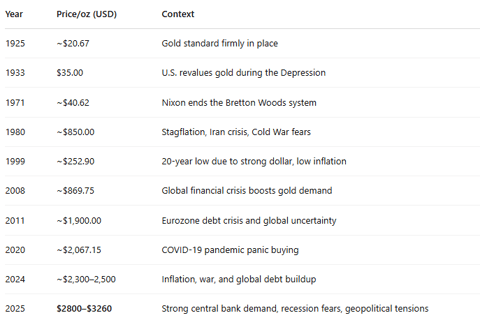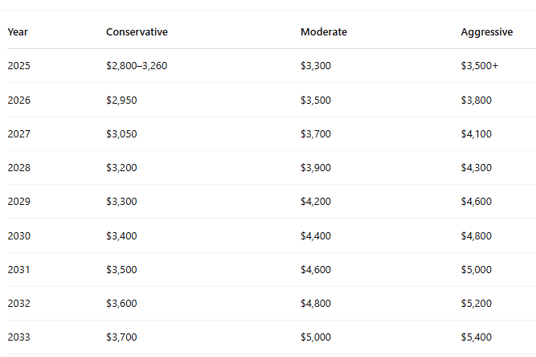Gold - Worlds Most Powerful Metal
Gold - Worlds Most Powerful Metal , History , Importance, Prediction
BULLIONS
4/11/20255 min read
Gold: A Century-Long Journey of Wealth, Power, and Economic Significance
Gold has fascinated humanity since the inception of civilization. Whether found in the tombs of pharaohs, the vaults of central banks, or the portfolios of prudent investors, this lustrous metal has maintained a timeless appeal. Over the last century, gold has transitioned from being a fundamental element of ancient empires to a safe-haven asset in an unpredictable global economy. By 2025, with prices anticipated to range between $2800 and $3260 per ounce, the continued significance of gold prompts critical inquiries regarding its historical, current, and future roles.
This article explores gold’s evolution from ancient significance to contemporary financial prominence, providing a comprehensive analysis of its price movements over the past century, along with future projections informed by current economic indicators.
Ancient Foundations: Gold as Power, Purity, and Divinity
In ancient civilizations, gold was not merely a valuable commodity; it held sacred significance. The Egyptians esteemed it as divine, referring to it as the "flesh of the gods." They adorned temples, palaces, and tombs with gold, believing it served as a connection between mortals and the divine. The funeral mask of Tutankhamun stands as one of history's most renowned gold artifacts, symbolizing not only wealth but also spiritual significance.
The Indus Valley, recognized as one of the world’s oldest civilizations, also possessed a rich culture surrounding gold. In India, gold has consistently represented purity, prosperity, and good fortune. It remains deeply integrated into religious ceremonies, festivals, and family traditions.
The Roman Empire formalized the use of gold as currency, introducing gold coins such as the aureus, which was later succeeded by the solidus under Constantine. These coins established a framework for future economies for centuries to come.
The Gold Standard and the Early 20th Century
Throughout much of the 19th and early 20th centuries, the global economy operated under the gold standard, wherein paper currency was backed by tangible gold. This system fostered a sense of stability and mitigated excessive monetary expansion. However, as global conflicts intensified, economic uncertainties also increased.
In 1933, amidst the Great Depression, U.S. President Franklin D. Roosevelt disconnected the dollar from gold within the domestic market and revalued gold from $20.67 to $35 per ounce. This action effectively devalued the dollar and established a precedent for future monetary policies.
A Century of Price Movements: Year-by-Year Highlights
The price trajectory of gold over the past century has been significantly influenced by global events, including wars, inflation, recessions, and financial crises. Below is a summary of key price points and events.
After 1971, when the United States completely removed the dollar's tie to gold, the price of gold transitioned into a free market system. This transition signified the emergence of gold as a volatile yet crucial financial instrument. Its first significant increase occurred in 1980, driven by concerns regarding inflation, the Iranian revolution, and Cold War tensions.
Following this period, prices declined for nearly two decades before rebounding in the early 2000s, coinciding with the burst of the tech bubble and the United States' prolonged military engagements in the Middle East. The crisis of 2008 propelled gold into a bull market, with prices reaching new heights in 2011 and again in 2020 during the pandemic.
2025: Gold in a Modern Economic Landscape
As of 2025, gold occupies a pivotal role in a rapidly evolving global financial system. Its price, fluctuating between $2800 and $3260 per ounce, reflects not only inflation but also a convergence of contemporary economic concerns and strategic adjustments.
1. Safe Haven in a Time of Uncertainty
Gold performs well during periods of uncertainty, and the events of the 2020s have certainly provided ample circumstances for such conditions. Conflicts in Eastern Europe, tensions in the Indo-Pacific, inflationary trends, and a growing skepticism towards fiat currencies have prompted investors to seek gold as a reliable store of value.
2. Central Bank Accumulation
Over the past five years, central banks in nations such as China, India, Turkey, and Russia have significantly increased their gold reserves. This trend is driven, in part, by a desire to reduce reliance on the U.S. dollar, mitigate currency volatility, and fortify national financial systems.
3. Digital Finance vs. Tangible Assets
Despite the rise of cryptocurrencies, their inherent volatility and regulatory challenges have bolstered gold’s status as a more dependable, tangible asset. Unlike digital currencies, gold is not contingent upon technological or internet infrastructure, thereby serving as a crucial backup asset.
4. Supply-Side Pressures
The cost of gold mining is escalating. Stricter environmental regulations, diminishing ore grades, and geopolitical instability in mining regions are constraining new supply. As production costs increase, so too does the baseline for gold prices.
Gold in Investment Portfolios
Professional asset managers consistently advocate for gold as a stabilizing element within investment portfolios. Its low correlation with stocks and bonds positions it as a significant diversification tool. In 2025, amidst volatility in equity markets and a cooling real estate sector, gold continues to be a preferred allocation for high-net-worth individuals as well as sovereign wealth funds.
Industrial and Technological Role
While investment and jewelry constitute the primary demand for gold, it also serves a crucial function in the fields of electronics, aerospace, and medicine. Due to its non-reactive properties, gold is essential for components in satellites as well as tools used in surgical procedures, ensuring its ongoing industrial significance.
Cultural and Social Continuity
In emerging markets such as India and China, gold transcends mere investment; it is a cultural imperative. The demand for gold remains robust for occasions such as weddings and festivals, even in the face of rising prices. This cultural foundation guarantees a consistent level of demand that bolsters global prices.
10-Year Gold Forecast (2025–2035)
The future of gold is expected to be influenced by a mix of economic conditions, geopolitical developments, and technological advancements. Below are three forecast scenarios:
Conservative Scenario: $3,500–$4,500/oz by 2035
In a context of moderate inflation, stable geopolitical conditions, and continued yet controlled monetary expansion, gold could appreciate steadily. Support from central banks and industrial demand would provide a foundation for prices.
Moderate/Bullish Scenario: $4,500–$5,500/oz
Should inflation remain above the targets set by central banks and political tensions rise in regions such as Taiwan, the Middle East, or Eastern Europe, gold may experience a significant rally. A global recession or a decline in confidence in fiat currencies could further accelerate this increase.
Aggressive/Upside Scenario: $5,500–$7,500+/oz
This scenario could materialize if the global financial system undergoes a substantial structural change—such as the introduction of a new reserve currency to replace the U.S. dollar, a severe debt crisis, or widespread failures of central bank digital currencies (CBDCs) prompting a shift towards physical assets.
The Enduring Brilliance of Gold
Gold has demonstrated its significance not merely as a historical artifact but also as a crucial element for comprehending future trends. Its evolution from ancient temples to contemporary trading platforms illustrates humanity's ongoing quest for value, security, and permanence. As we approach 2025, amid increasing global instability and a shifting financial landscape, the importance of gold is expected to escalate.
Gold's function as a hedge, reserve asset, and cultural cornerstone guarantees sustained demand, while constraints on supply and economic uncertainty are likely to drive prices higher. In the coming decade, gold may not only serve to preserve wealth but also play a defining role in it.





